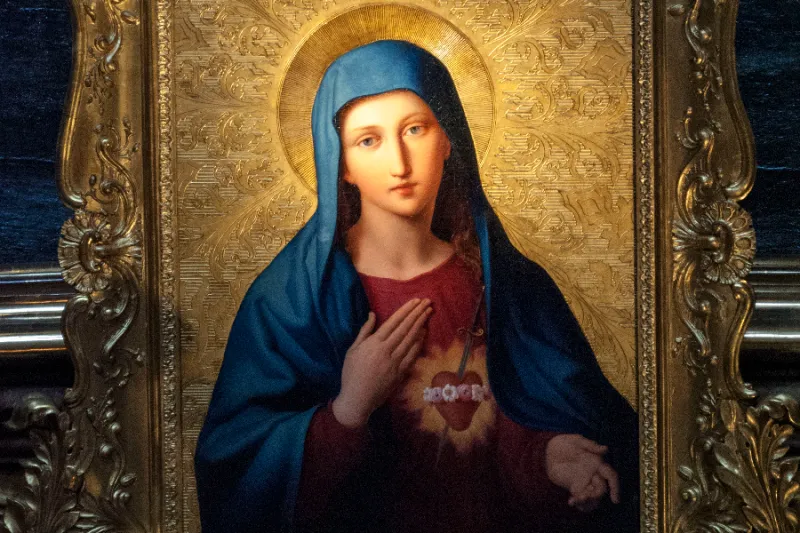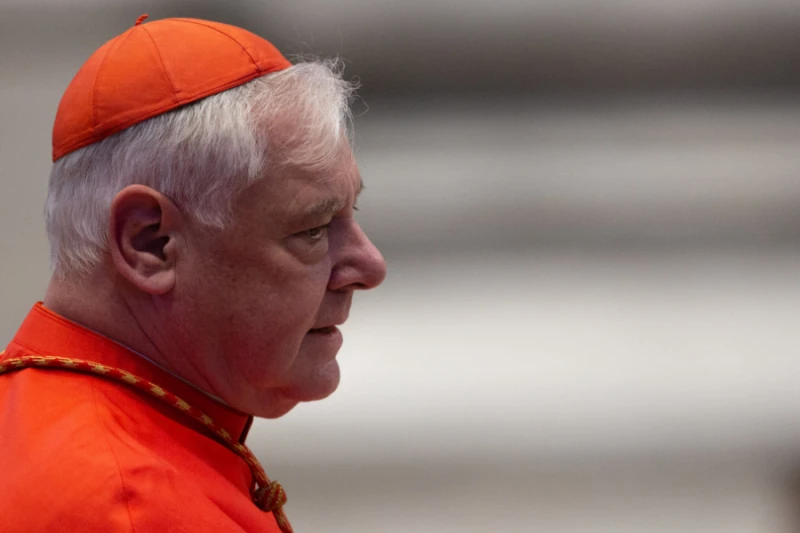
Synodality and Sanctity
Pope Benedict XVI often said that, in today’s skeptical and cynical world, the saints make a more persuasive case for the truth of Christianity than the most sophisticated arguments. One has to wonder, then, why […]

Pope Benedict XVI often said that, in today’s skeptical and cynical world, the saints make a more persuasive case for the truth of Christianity than the most sophisticated arguments. One has to wonder, then, why […]

Cardinal Fernando Filoni / Daniel Ibáñez / CNA
Rome Newsroom, Nov 9, 2022 / 07:00 am (CNA).
The mission of the Church today is not just shaped by current political realities and recent developments in the Church but by finding a focus in Christ… […]

Pope emeritus Benedict XVI. / Mazur/catholicnews.org.uk.
Washington, D.C. Newsroom, Oct 21, 2022 / 07:05 am (CNA).
In a new letter, Pope Emeritus Benedict XVI characterizes the Second Vatican Council as “not only meaningful, but necessary.”Rele… […]

 An image of the Immaculate Heart of Mary at St. Peter’s Church, Vienna, Austria. / Diana Ringo via Wikimedia (CC BY-SA 3.0 at).
An image of the Immaculate Heart of Mary at St. Peter’s Church, Vienna, Austria. / Diana Ringo via Wikimedia (CC BY-SA 3.0 at).
Washington, D.C. Newsroom, Oct 17, 2022 / 10:00 am (CNA).
Nearly 60 years ago, Vatican II recognized several titles of the Blessed Virgin Mary. But it focused on one in particular: “Mother.”
On Oct. 11, the Catholic Church marked the 60th anniversary of the opening of the Second Vatican Council, more commonly known as Vatican II. While the council addressed many issues, it aimed to present the Church to the modern world. Bishops worldwide gathered at St. Peter’s Basilica in Rome for the event, which consisted of a series of four deliberative sessions from 1962 until 1965.
One of the principal documents produced by the council features a chapter centered on Mary. Lumen gentium, the Dogmatic Constitution on the Church, was released by Pope Paul VI on Nov. 21, 1964.
During an address that day, the Roman pontiff confirmed Mary’s title as “Mother of the Church” and called the chapter about her Lumen gentium’s “apex.”
“For it is the first time — and to say so fills our hearts with deep emotion — that an Ecumenical Council has presented such an extensive synthesis of Catholic doctrine on the place of Mary Most Holy in the mystery of Christ and of the Church,” he said.
Here are eight things it says about Mary.
‘Truly the Mother of God’
Lumen gentium describes Mary’s intimate relationship with the three persons of the Holy Trinity.
“The Virgin Mary, who at the message of the angel received the Word of God in her heart and in her body and gave Life to the world, is acknowledged and honored as being truly the Mother of God and Mother of the Redeemer,” Lumen gentium reads. “Redeemed by reason of the merits of her Son and united to Him by a close and indissoluble tie, she is endowed with the high office and dignity of being the Mother of the Son of God, by which account she is also the beloved daughter of the Father and the temple of the Holy Spirit.”
Mother of the Church
The document emphasizes that while Mary surpasses all creatures in heaven and on earth, she is, at the same time, “one with all those who are to be saved.”
“The Catholic Church, taught by the Holy Spirit, honors her with filial affection and piety as a most beloved mother,” the document reads.
Participant in the ‘Economy of Salvation’
Mary plays an important role in humanity’s salvation, Vatican II affirmed.
“With her the exalted Daughter of Sion, and after a long expectation of the promise, the times are fulfilled and the new Economy established, when the Son of God took a human nature from her, that He might in the mysteries of His flesh free man from sin,” Lumen gentium says.
The new Eve
The document contrasted Mary’s obedience to Eve’s disobedience in the Garden of Eden.
“The Father of mercies willed that the incarnation should be preceded by the acceptance of her who was predestined to be the mother of His Son, so that just as a woman contributed to death, so also a woman should contribute to life,” the document stresses.
‘Handmaid of the Lord’
Mary’s “yes” to being the mother of God made her an active participant, the council pointed out.
“Embracing God’s salvific will with a full heart and impeded by no sin, she devoted herself totally as a handmaid of the Lord to the person and work of her Son, under Him and with Him, by the grace of almighty God, serving the mystery of redemption,” the dogmatic constitution reads. “Rightly therefore the holy Fathers see her as used by God not merely in a passive way, but as freely cooperating in the work of human salvation through faith and obedience.”
‘Queen of the universe’
The document also recognizes Mary as queen.
“Finally, the Immaculate Virgin, preserved free from all guilt of original sin, on the completion of her earthly sojourn, was taken up body and soul into heavenly glory, and exalted by the Lord as Queen of the universe, that she might be the more fully conformed to her Son, the Lord of lords and the conqueror of sin and death,” the document declares.
‘Model of virtues’
Mary is, as the document calls her, the “model of virtues.”
“Piously meditating on her and contemplating her in the light of the Word made man, the Church with reverence enters more intimately into the great mystery of the Incarnation and becomes more and more like her Spouse,” it reads. “For Mary, who since her entry into salvation history unites in herself and re-echoes the greatest teachings of the faith as she is proclaimed and venerated, calls the faithful to her Son and His sacrifice and to the love of the Father.”
‘Sign of hope and solace’
Mary, the document concludes, will “shine forth on earth, until the day of the Lord shall come, as a sign of sure hope and solace to the people of God during its sojourn on earth.”
She constantly intercedes for humanity, it adds.
“The entire body of the faithful pours forth instant supplications to the Mother of God and Mother of men that she, who aided the beginnings of the Church by her prayers, may now, exalted as she is above all the angels and saints, intercede before her Son in the fellowship of all the saints,” the document states, “until all families of people, whether they are honored with the title of Christian or whether they still do not know the Saviour, may be happily gathered together in peace and harmony into one people of God, for the glory of the Most Holy and Undivided Trinity.”

Debates and controversies over matters of doctrinal development never happen in a vacuum or in the abstract. Which is why it is always critical to assess both the intellectual milieu in which such debates take […]

Readings: • Jer 38:4-6, 8-10 • Ps 40:2, 3, 4, 18 • Heb 12:1-4 • Lk 12:49-53 In the summer of 2007, the Congregation for the Doctrine of the Faith released a document containing “responses […]

 Cardinal Gerhard Müller at a penance service in St. Peter’s Basilica on March 29, 2019. Credit: Daniel Ibáñez/CNA.
Cardinal Gerhard Müller at a penance service in St. Peter’s Basilica on March 29, 2019. Credit: Daniel Ibáñez/CNA.
Rome, Italy, Aug 2, 2022 / 16:00 pm (CNA).
Cardinal Gerhard Ludwig Müller, prefect emeritus of the Congregation for the Doctrine of the Faith, has sharply criticized the Synodal Way in Germany.
In an interview with EWTN Vatican / CNA Deutsch, the 74-year-old cardinal said that the Synodal Way, declared a “reform process” by its initiators, is “over” and was on an “anti-Catholic, wrong track.”
The Holy See issued a statement June 21 noting that the Synodal Way was “not authorized” to “oblige the bishops and the faithful to adopt new forms of governance and new orientations of doctrine and morals.” It was “necessary” to clarify this in order to “safeguard the freedom of the people of God and the exercise of the episcopal ministry.”
The Synodal Presidium — consisting of the German Bishops’ Conference and the Central Committee of German Catholics (ZdK) — then accused the Vatican of a lack of willingness to communicate. It stated: “Unfortunately, the synodal presidium has not been invited to a conversation until today. That this direct communication does not take place so far, we regret irritated. Synodal church goes after our understanding differently! This also applies to the way of today’s communication, which astonishes us. It does not testify to a good style of communication within the Church when statements are published that are not signed by name.”
Cardinal Müller called these statements “intolerable,” and added that this “really has nothing to do with synodality and collegiality, nor with respect for the episcopal office.” He said the Holy See’s statement expressed nothing but the “simple principle of Catholic ecclesiology.”
When asked whether the Synodal Way in Germany was now at an end after the declaration from Rome, as the Münster canon lawyer Thomas Schüller wrote on Twitter, Cardinal Müller replied: “I think the Synodal Way was doomed from the start, it’s just that its initiators haven’t realized it yet.”
Müller said that the Synodal Way in Germany has nothing to do with “synodality,” nor with “way”. Rather, the construct is reminiscent of a “political organization” that considers itself the “vanguard of the universal Church.”
The cardinal said: “Revelation is entrusted to the Church for faithful preservation, and not, as the Synodal Way meant at the beginning, that this virtually randomly assembled body somehow has the right and authority to override the Church’s sacramental constitution and reinterpret Revelation according to its meaning.”
It was the “birth defect of this body” to set itself up as a vanguard of the Church, he said.
“What is being pursued here is nothing other than division,” Cardinal Müller lamented. “It is a so-called reform with a crowbar.”
Among supporters of the Synodal Way there was an “intransigence,” the cardinal said, resulting from “a lack of knowledge of Catholic ecclesiology.”
Müller reflected on the president of the ZdK, Irme Stetter-Karp, who had emphasized in an article for the Hamburg weekly “Die Zeit” that it should be “ensured that the medical intervention of an abortion is made possible across the board.”
Cardinal Müller said, “Whoever wants to guarantee these crimes, area-wide for the entire population, cannot pose as a reformer of the Church.”
“After all, the Church is not the object of our reform. The Church is founded by Christ, cannot be reformed, is unsurpassable; only we can go the way and must go the way of repentance and renewal,” he added. “We must reform and renew ourselves in Jesus Christ and thus give the answer to the challenges of today.”

A few months ago, I interviewed the patristics scholar, Dr. Lewis Ayres. Dr. Ayres is understandably very favorably disposed towards the school of modern theology that has come to be known as “ressourcement” theology. However, […]

I agree with everything Larry Chapp says in his recent pieces on the problems of “synodality.” But, perhaps very slightly more hopeful than he is, I want to make some suggestions overlooked by many in […]

In my previous essay I criticized the new emphasis on synodality as an essentially modern enterprise of bureaucratic legerdemain. I noted that while I support the concept of a more synodal Church, I am suspicious […]
© Catholic World Report